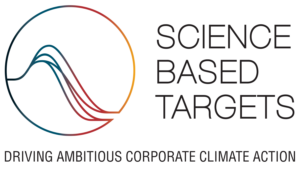Also check out our Sustainability Terms Glossary, where we’ll add key terms from each of our Deep Dives over time. Bookmark this page for future reference! 
Looking for information on CDP? Check out our Deep Dive on CDP here.
In March 2023, the Science-Based Target initiative (SBTi) approved Atlantic’s SBTs for climate action, including our goal to reach net-zero greenhouse gas (GHG) emissions by 2046. As more companies are setting SBTs and submitting climate action information through CDP, we wanted to provide more background on the alphabet soup of climate disclosure and action. In Part 2 of this Deep Dive, we’ll dive into what SBTs are and why they’re important both to Atlantic and our customers. Check out Part 1 on CDP here.
What are Science-Based Targets, and why are they important?
For several decades, the United Nations has convened countries to try to come to various agreements to mitigate climate change. In 2015, the United Nations Framework Convention on Climate Change (UNFCCC)’s Paris Agreement helped governments around the world commit to limiting global temperature rise to well below 2°C above pre-industrial levels. This was a huge deal — the agreement represents some of the most significant global cooperation on climate change made to date and creates a clear line in the sand demarcating the level of warming we want to avoid.
To stay below 2°C, the necessary reductions to limit the warming are dramatic: as a global community, we need to cut GHG emissions in half by 2030 and reach net zero by 2050.
Many companies have made various pledges over the previous years to limit their emissions, but they were difficult to compare to each other and often intentionally vague. If we are going to truly limit emissions in line with the Paris Agreement, we need a way for companies to make data-driven, verified, meaningful commitments that are comparable to each other.
CDP teamed up with the UN Global Compact and other leading environmental organizations to create the Science Based Targets initiative (SBTi). Its goal is to help companies determine how much and how quickly they need to reduce emissions. As the name suggests, science-based targets are validated, data-driven commitments showing that a company is doing its part to reach net zero in line with the Paris Agreement.
What makes SBTs different from previous kinds of climate commitments?
Historically, many companies’ climate commitments have focused heavily on carbon offsets. A carbon offset is a reduction in GHG emissions made by one party to compensate for the emissions produced by another party. This is typically achieved by investing in projects that reduce or remove GHGs from the atmosphere, such as renewable energy, energy efficiency, or reforestation projects. The reduction in emissions is then quantified and can be purchased as a carbon offset by companies or individuals looking to offset their own emissions.
One of the main criticisms of carbon offsets is that they are sometimes seen as a way for companies to continue emitting GHGs without actually reducing their carbon footprint. In other words, carbon offsets can be seen as a “license to pollute,” allowing companies to offset their emissions rather than making the necessary investments in renewable energy or energy efficiency measures to reduce their emissions.
In this way, many companies are more focused on the “net” part of a “net zero” GHG emissions goal – they can continue emitting GHGs so long as they pay to offset those emissions elsewhere. Carbon offsets have a role to play in mitigating climate change, but if we are going to make the amount of change needed, we need companies to actually focus on reducing their absolute emissions.
Science-based targets are considered the gold standard in corporate climate action because of the level of validation and the kind of climate action required. SBTi’s net-zero actions focus more on the “zero” and less on the “net.” SBTi has strict requirements that only 10% of net-zero reductions can be achieved through offsets, meaning that companies with science-based targets must truly reduce their operational and supply chain emissions to meet their goals.
What is the relationship between SBTs and CDP?
CDP and SBTi are closely interrelated: CDP provides the data and insights that companies need to set science-based targets and track their progress toward achieving them. Companies that disclose their environmental impacts through CDP can also receive guidance and support from the SBTi on setting and achieving science-based targets. Moreover, companies that set science-based targets are often recognized by CDP for their environmental leadership and performance.
You can think of CDP as the “grade” for how well a company is doing in taking climate action. A company’s SBTs are its goals to improve its climate impact. Having an SBT and working to achieve it usually means a better CDP score.
What are Atlantic’s SBTs?
Atlantic set ambitious targets for climate action that were approved by SBTi in March 2023. Atlantic is the first packaging and containers company in North America to have a net-zero target approved by SBTi.
Overall Net-Zero Target:
- Atlantic commits to reach net-zero greenhouse gas emissions across its value chain by 2046, which is Atlantic’s 100th birthday.
Near-Term Targets:
- Atlantic commits to reduce Scope 1 and 2 greenhouse gas emissions 70% by 2030, from a 2021 base year.
- Atlantic also commits that 55% of its suppliers by spend, covering purchased goods and services, will have science-based targets by 2027.
- Atlantic further commits to reduce 25% of its Scope 3 greenhouse gas emissions from purchased goods and services by 2030, from a 2021 base year.
Long-Term Targets:
- Atlantic commits to reach net-zero greenhouse gas emissions across its value chain by 2046.
- Atlantic commits to reduce Scope 1, 2, and 3 greenhouse gas emissions 90% by 2046, from a 2021 base year.
